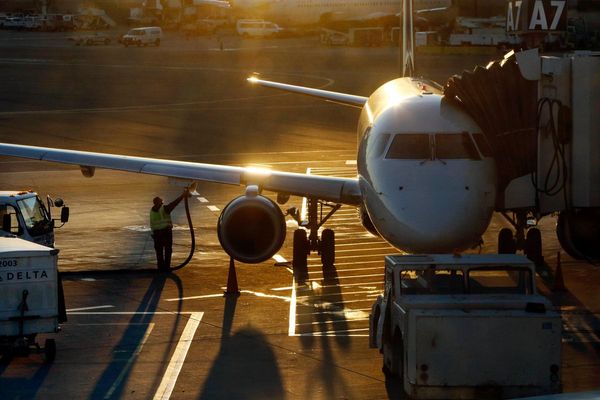
Cruise ships visiting Britain are frequently failing to plug into “zero emission” onshore power and instead running their engines and polluting the local environment with fumes.
The industry is under scrutiny over air pollution and contribution to greenhouse gases, with some European cities banning vessels from central ports. Cruise operators say ships can reduce emissions by switching off engines and plugging into low-carbon electricity when moored. But an investigation by openDemocracy has found that cruise ships regularly fail to use onshore power at Southampton, Britain’s largest cruise port.
They instead rely on marine gas oil, which contributes to local air pollution, or liquefied natural gas (LNG), which has lower air pollutants but leads to some methane being emitted into the atmosphere. Both fuels contribute to greenhouse gas emissions.
An analysis of ship schedules at Southampton found that between April 2022 and July 2023, there were about 300 days when at least one cruise ship was docked at the port, but the onshore power facility was only used 71 times over the same period.
Some ships have not been adapted to use cleaner onshore power, but the UK Chamber of Shipping says one factor is cost, because onshore power is more expensive than marine fuel. Cruise firms can also pay for their ships to be retrofitted with new technology so they can use cleaner onshore power.
Jon Hood, UK sustainable shipping manager at Transport & Environment (T&E), Europe’s leading clean transport campaign group, said: “There’s clean power available but the cruise companies don’t want to pay for it.”
He said greater transparency was required and cruise operators should be forced to disclose when they use onshore power and for how long, and that the government should require cruise ships to plug into onshore power when it was available.
Katherine Barbour, Southampton’s first Green party councillor, said: “If cruise liners aren’t mandated to change, this will continue and our residents will suffer. We need all berths to be able to provide onshore power, and ships need to be adapted to use it.
“Every ship is like a small town, spewing out pollution when they are not using electricity.”
The New York Times reported in December 2019 that a single docked cruise ship can emit in a day as much diesel exhaust as 34,400 idling lorries, but that that was almost eliminated with onshore power. The cruise industry says the analysis does not consider advanced technologies on cruise ships used to reduce emissions, the use of alternative fuels, or restrictions on emissions in ports.
While cruising is one of the fastest growing tourism sectors, with 31.5m passengers forecast for 2023, there are concerns about its environmental impact. A study published in the journal Marine Pollution Bulletin in December 2021 found a large cruise ship could have a carbon footprint greater than 12,000 cars. An analysis published in June by T&E found that despite the introduction of a new cap of sulphur in marine fuels in 2020, 218 cruise ships operating in Europe in 2022 emitted more sulphur oxides than a billion cars.
In 2021, Venice banned cruise ships from its historic centre. Amsterdam banned cruise ships from its centre earlier this year and Barcelona followed suit from 22 October.
The industry also says it is committed to greener practices, with a target of net zero carbon cruising by 2050. Carnival Corporation, the world’s largest leisure travel company, is building new ships powered by LNG, and cruise operators are also conducting trials with biofuels. New LNG engines reduce emissions of sulphur oxides but campaigners say the engines and the fuel production process leak methane, an extremely potent greenhouse gas.
In April 2022, Associated British Ports (ABP), which operates the cruise cruise port at Southampton, announced the launch of an onshore power facility offering “zero emissions at berth”. The project cost £9m, supported by £4.4m from the Solent local enterprise partnership, which has significant public funding. But only one ship can plug into that facility at a time.
The 2022 Solent LEP annual report said shore power had saved 1.7m kg of CO2 in a year; that is only a fifth of the annual savings predicted by ABP in its business case submitted to the LEP to obtain the £4.4m grant. ABP said implementation takes time to “work up”.
The Cruise Lines International Association says 46% of its member fleet can connect to shoreside electricity. It said in September that 32 ports had at least one cruise berth with shoreside power, and plugging in could reduce emissions by up to 98%. A spokesperson said: “Connecting to shoreside electricity is a long-term element in the cruise industry’s decarbonisation strategy.”
ABP said: “ABP Southampton is proud to be a UK leader in the provision of shore power. It’s a service to our shipping customers that we want to grow. We see shore power as an integral part of the transition to net zero for both ABP and our customers.
“The port of Southampton has a UK-leading air-quality improvement and emissions reduction strategy, backed by a network of air quality monitors around the port. Real world air-quality monitoring research by Southampton city council demonstrates that air quality levels for port-related emissions are a fraction of other sources such as traffic.”
Port officials say there are various factors involved in the use of the onshore power facility, which may include the fact that UK power costs are some of the highest in Europe. ABP said it planned to publish a 2023 shore-power performance review early next year, with its air quality update.Carnival Corporation said: “We use shore power in ports wherever available and operationally possible. However, despite the benefits, just 2% of the world’s ports have at least one cruise berth equipped with onshore power.”







